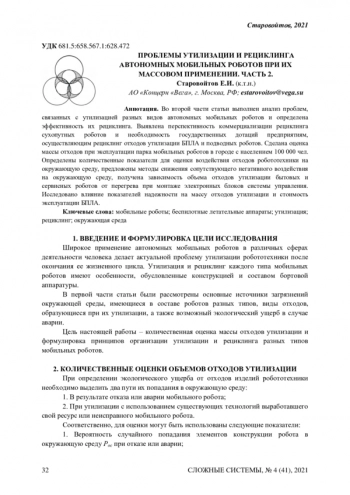Во второй части статьи выполнен анализ проблем, связанных с утилизацией разных видов автономных мобильных роботов и определена эффективность их рециклинга. Выявлена перспективность коммерциализации рециклинга сухопутных роботов и необходимость государственных дотаций предприятиям, осуществляющим рециклинг отходов утилизации БПЛА и подводных роботов. Сделана оценка массы отходов при эксплуатации парка мобильных роботов в городе с населением 100 000 чел.
Определены количественные показатели для оценки воздействия отходов робототехники на
окружающую среду, предложены методы снижения сопутствующего негативного воздействия
на окружающую среду, получена зависимость объема отходов утилизации бытовых и
сервисных роботов от перегрева при монтаже электронных блоков системы управления.
Исследовано влияние показателей надежности на массу отходов утилизации и стоимость
эксплуатации БПЛА.
In the second part of this article analyzes the problems associated with the utilization of various types of autonomous mobile robots and determines the efficiency of their recycling. The prospects of commercialization of recycling of ground robots and the need for state subsidies to enterprises engaged in recycling of UAVs and underwater robots are established. An assessment of the mass of waste during the operation of a fleet of mobile robots in a city with a population of 100,000 people has been carried out. Quantitative indicators for assessing the impact of robotics waste on the environment and methods for reducing the accompanying negative impact on the environment has been determined, the dependence of the volume of waste of household and service robots’s utilization on overheating during the assembly of electronic control system units is obtained.
The influence of reliability indicators on the mass of waste of UAV’s utilization and the cost of UAV
operation has been investigated.




